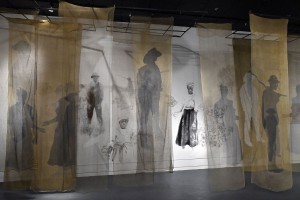As Black History Month is celebrated this February, the nation honors the history and contributions of African Americans. The University of Rhode Island Alan Shawn Feinstein College of Education and Professional Studies is exhibiting an impressive show titled “Visible Cloth, Invisible Bodies – Rhode Island Textiles and Southern Slavery in the 19th Century.”
 Entering the exhibition, you travel back to a time when RI played a significant part in the transatlantic slave trade that made possible the textile industry growth in New England. With a host of artifacts to view, I found the cotton plants (yes, you can touch) added a moving element to the already well-thought-out floor plan. “People often don’t realize that cotton plants, when they are picked, they are dead and they are sharp and they are nasty. Touching them makes all of that a bit more real,” says Steven Pennell, coordinator of the Urban Arts and Culture Program at URI’s Providence Campus.
Entering the exhibition, you travel back to a time when RI played a significant part in the transatlantic slave trade that made possible the textile industry growth in New England. With a host of artifacts to view, I found the cotton plants (yes, you can touch) added a moving element to the already well-thought-out floor plan. “People often don’t realize that cotton plants, when they are picked, they are dead and they are sharp and they are nasty. Touching them makes all of that a bit more real,” says Steven Pennell, coordinator of the Urban Arts and Culture Program at URI’s Providence Campus.
The galleries included large-scale historical photos of southern farms, chattel slaves, under-aged children working in factories and precious weathered elders who cared for plantation families throughout several generations. The images are haunting and serve as a constant reminder that RI textile factories kept youth and women working long hours with little pay and wretched conditions. In 1824, 102 Pawtucket women textile workers went on strike, refusing to return until their old wages were restored. Making history, the strike was the first for working women in the US.
A small-scale model replicating the Slater Mill and a loom gives us insight into the country’s first cotton-spinning factory. It was very successful in producing cotton thread for various textile mills in RI. Cotton was sold to RI mostly from the south, where the mills began dominating the northern landscape. The fabric was used for clothing and was labor intensive and expensive to make when compared to wool and linen, also homespun. Among all this factory work are samples of payroll ledgers from various Rhode Island mills. They are enhanced with city and town scaled maps of rivers, streets and named establishments. Most African American families worked at the mills for one dollar a day.
“It was a revelation to realize that RI merchants were responsible for bringing slaves not only to plantations in the South, but also to mills in New England. Even after slavery had been abolished,  this was going on. There were people enslaved on plantations and then virtually enslaved in mills, being moved back and forth like the cotton. I had no idea they were bringing African slaves to work in the mills here. Some of the financial cycle included making sub-par clothing and shoes and materials for the slaves in the South, supporting the institution for financial gain here in the North,” adds Pennell.
this was going on. There were people enslaved on plantations and then virtually enslaved in mills, being moved back and forth like the cotton. I had no idea they were bringing African slaves to work in the mills here. Some of the financial cycle included making sub-par clothing and shoes and materials for the slaves in the South, supporting the institution for financial gain here in the North,” adds Pennell.
Newspaper clippings and mappings of slave trade from prominent RI families show that the voyages were plentiful and the capital accumulation immense. Rosters were kept and visuals of ship transportation of slaves had well-thought-out plans and drawings. With these images, a local artist, Deborah Baronas, created drawings and ghost-like shadows of life-sized images on airy linen pallets. Her work is based on her own work experience and family heritage. She constantly explores the condition of the American worker along with the landscape, and her work is a perfect addition to this exhibit.
The spirits are with us here as a lingering reminder that history was alive and made its mark on our state.
To obtain more information about the exhibit, call or visit: 401-277-5206, uri.edu/ceps/prov/arts; gallery hours: 80 Washington St, PVD. Mon – Thu, 9am – 9pm. Fri and Sat 9am – 4pm. Closed Sun.


